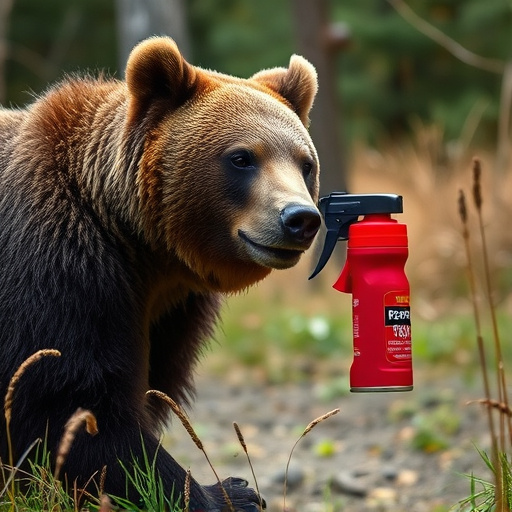Bear spray, using capsaicin oleoresin from chili peppers, is an eco-friendly alternative to traditional deterrents. This natural compound effectively repels bears without harming ecosystems or non-target species when used responsibly. Plant-based and biodegradable formulations further reduce environmental impact, making bear spray a viable Is Bear Spray Eco Friendly Alternative for outdoor enthusiasts.
Bear spray is a popular defense mechanism for outdoor enthusiasts facing potential bear encounters. This article delves into the composition of bear spray, focusing on its key active ingredient, capsaicin oleoresin. We explore the environmental impact of traditional bear sprays and present eco-friendly alternatives. Additionally, we discuss the safety and effectiveness of capsaicin, shedding light on why it remains a game-changer in bear deterrents, including whether it offers an eco-conscious solution compared to conventional options.
- Understanding Bear Spray Composition
- Capsaicin Oleoresin: The Key Ingredient
- Environmental Impact of Bear Spray
- Eco-Friendly Alternatives to Consider
- Safety and Effectiveness of Capsaicin in Bear Spray
Understanding Bear Spray Composition
Bear spray, a popular deterrent for encounters with bears, is more than just a simple mixture of chemicals. At its core, it’s a complex composition designed to effectively scare off potential threats while minimizing harm. The primary active ingredient in bear spray is capsaicin oleoresin, derived from chili peppers. This component gives bear spray its pungent and irritant properties, stimulating the eyes, nose, and respiratory system of bears, causing them to retreat.
When considering if bear spray is an eco-friendly alternative, it’s important to note that while it’s less harmful than bullets or other lethal methods, capsaicin oleoresin itself can have environmental impacts. However, many modern bear sprays are formulated with a focus on sustainability and safety for both humans and wildlife. These eco-conscious options often use lower concentrations of capsaicin, ensuring minimal ecological disruption while still offering effective protection. Thus, choosing the right brand and understanding its composition is key to leveraging bear spray as an environmentally friendly deterrent in wild environments.
Capsaicin Oleoresin: The Key Ingredient
Capsaicin oleoresin is the star ingredient in bear spray, making it a powerful yet eco-friendly alternative to traditional deterrents. This natural compound, derived from chili peppers, packs a punch that can stop aggressive bears in their tracks. Its effectiveness lies in its ability to activate pain receptors in the bear’s nose and mouth, triggering a temporary but intense response.
Unlike other chemicals often found in repellents, capsaicin oleoresin is biodegradable and non-toxic to humans and most wildlife species. This eco-conscious aspect makes it an appealing choice for outdoor enthusiasts who want to protect themselves while minimizing their impact on the environment. Its natural origin ensures a safer option, especially for areas with diverse ecosystems and sensitive wildlife populations.
Environmental Impact of Bear Spray
Bear spray, particularly those containing capsaicin oleoresin, often faces scrutiny regarding its environmental impact. While it’s commonly recognized as a safer option than traditional firearms or rubber bullets for deterring bears, debates persist about its ecological effects. The primary active ingredient, capsaicin, is derived from chili peppers and can pose risks to non-target species if misused or not disposed of properly.
However, when used responsibly within designated areas and following manufacturer guidelines, bear spray can be considered an eco-friendly alternative. Proper application techniques ensure minimal spreading, reducing potential harm to sensitive ecosystems. Moreover, ongoing research into more biodegradable formulations suggests a commitment within the industry to create products that better align with environmental conservation efforts.
Eco-Friendly Alternatives to Consider
Many outdoor enthusiasts and advocates are increasingly looking for eco-friendly alternatives to traditional bear spray, especially as awareness about environmental impact grows. While the primary purpose of bear spray is to deter and protect against aggressive bears, some conventional options contain chemicals that can have harmful effects on wildlife and ecosystems.
One promising alternative gaining traction is capsaicin oleoresin, a natural compound derived from chili peppers. This ingredient has been shown to be effective in repelling bears without leaving behind toxic residues. Additionally, there are efforts to develop plant-based and biodegradable formulations, ensuring that bear spray can still serve its protective function while minimizing environmental harm. These eco-conscious alternatives offer a promising path forward for outdoor adventurers seeking to coexist harmoniously with nature’s wild inhabitants.
Safety and Effectiveness of Capsaicin in Bear Spray
Capsaicin, the active ingredient in bear spray, has long been recognized for its potent effects on various animals’ sensory systems. This natural compound, derived from chili peppers, is a non-lethal option that offers an eco-friendly alternative to other wildlife deterrents. Its safety and effectiveness have been well-documented, making it a preferred choice for outdoor enthusiasts and individuals living in bear-infested areas.
When used responsibly, capsaicin spray can create a powerful barrier against aggressive bears without causing significant harm. The irritant nature of capsaicin disrupts the animal’s sense of smell and taste, temporarily disorienting them and encouraging a safe retreat. This non-lethal approach is particularly appealing to those seeking sustainable solutions for bear interaction management, making it an attractive option in today’s environmentally conscious world.
Bear spray, while effective in deterring bears, raises concerns about its environmental impact. Key ingredient capsaicin oleoresin, known for its potent effects, also poses challenges for ecosystems. Exploring eco-friendly alternatives is crucial to balancing safety and sustainability. While conventional bear spray may not be an entirely green option, understanding its composition opens doors to developing more environmentally sound solutions, potentially offering a safer, more sustainable approach to bear encounter prevention. Considering these factors, the search for an effective yet eco-conscious alternative, like non-lethal deterrents or specialized plant-based sprays, could lead to a more harmonious coexistence between humans and bears.
